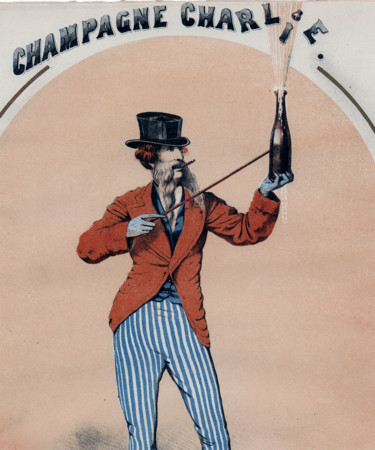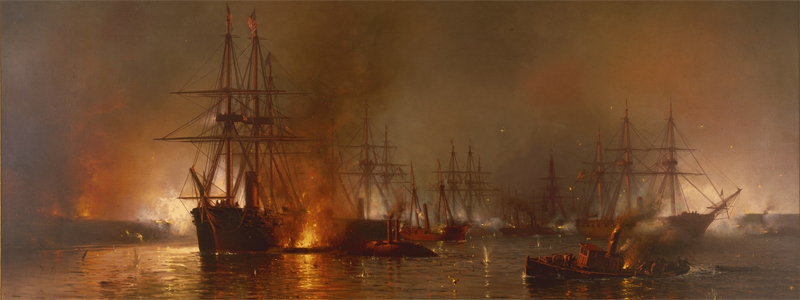He’s known as the man who popularized Champagne in America. He was also held as a Confederate spy for months, that is until Emperor Napoleon the Third impressed upon President Lincoln to secure his release. A broke, broken man, he made a comeback when someone gave him the deeds to a third of all the land in a then-barely-known town called Denver.
Is any of it true? Actually, most of it is. But when you get into the details things get hazy. We’re not talking about ancient history, so why the confusion?
To understand the improbably true tale of Charles ‘Champagne Charlie’ Heidsieck’s life you need to understand the type of marketer we’re discussing here. Winning for oneself the nickname ‘Champagne Charlie,’ awarded by one of the many New York City newspapers of the day, doesn’t begin to explain the self-promoting type of man in question. To truly understand, you need to look back at a stunt Mr. Heidsieck’s father, Charles-Henri attempted to pull off during Napoleon’s infamous, failed invasion of Russia:
“Charles’ father (Charles-Henri) famously rode on a white stallion in 1811, just ahead of Napoleon’s advancing army, all the way to Russia as a publicity stunt. Master promoter, his father arrived in Moscow with cases of Champagne and his order book.”
The goal being, of course, to sell Champagne to whichever side won.
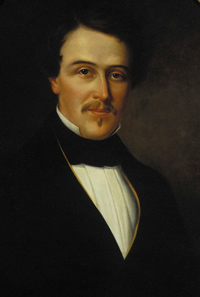 Charles Heidsieck was born in 1822. In 1851, at the age of 29, he founded his own Champagne House (other members of his family founded the houses that grew to become Piper-Heidsieck and Heidsieck & Co Monopole). A year after going into business, he set sail for the United States. After establishing an importing firm in New York City, with a local sales agent, he set off on a marketing trip throughout New England. His brand established as a new, popular, celebratory drink, he returned to France. Tremendous success followed. His Champagne was distributed up and down the Eastern Seaboard. ‘Thousands of bottles per annum’ were consumed in French-influenced New Orleans alone.
Charles Heidsieck was born in 1822. In 1851, at the age of 29, he founded his own Champagne House (other members of his family founded the houses that grew to become Piper-Heidsieck and Heidsieck & Co Monopole). A year after going into business, he set sail for the United States. After establishing an importing firm in New York City, with a local sales agent, he set off on a marketing trip throughout New England. His brand established as a new, popular, celebratory drink, he returned to France. Tremendous success followed. His Champagne was distributed up and down the Eastern Seaboard. ‘Thousands of bottles per annum’ were consumed in French-influenced New Orleans alone.
When Heidsieck returned to New York, five years later, he was no longer Charles Heidsieck, he was Champagne Charlie. According to multiple histories he was greeted with pomp, newspaper coverage, and evening after evening of high-society banquets where the Champagne flowed freely. On one of his subsequent trips to the US, he wrote, in a letter to his wife Amélie, of the citizens of New Orleans:
“They are warm, they are hospitable, they are generous … and they love to eat and drink!”
Confederate Spy?
Heidsieck had taken a great risk, hinging the success of his young business on a personally driven gamble to open the American market. The risks he took were rewarded with ‘roaring success.’ Reported sales in the US – almost impossibly not exaggerated – had reached past 300,000 bottles by 1861. That would be the year the American Civil War broke out.
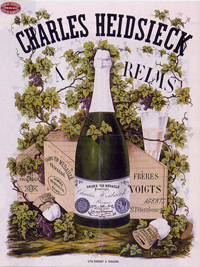 Champagne Charlie’s booming Champagne business was highly dependent on exports to a country that was now at war with itself. With half his assets tied up in unpaid American accounts, Heidsieck sailed to New York. What happened next is reported in half-a-dozen different ways, but the outcome is always the same. Heidsieck’s New York sales agent claimed the debts invalid – pushing Heidsieck to the edge of ruin. In some accounts the man claimed that an act of Congress, which absolved Northerners of their cotton debts to Southerners, excised his Champagne debt. Another account cites a similar Confederate act aimed to absolve debts in the opposite direction. Still others claim Heidsieck’s American partner simply lied his way out of the debt, citing a non-existent law. A difficult-to-source account on an English-language, French-produced website claims it was the partner’s greed and wish to ‘knock Charlie from his pedestal and to pad his own pockets.’
Champagne Charlie’s booming Champagne business was highly dependent on exports to a country that was now at war with itself. With half his assets tied up in unpaid American accounts, Heidsieck sailed to New York. What happened next is reported in half-a-dozen different ways, but the outcome is always the same. Heidsieck’s New York sales agent claimed the debts invalid – pushing Heidsieck to the edge of ruin. In some accounts the man claimed that an act of Congress, which absolved Northerners of their cotton debts to Southerners, excised his Champagne debt. Another account cites a similar Confederate act aimed to absolve debts in the opposite direction. Still others claim Heidsieck’s American partner simply lied his way out of the debt, citing a non-existent law. A difficult-to-source account on an English-language, French-produced website claims it was the partner’s greed and wish to ‘knock Charlie from his pedestal and to pad his own pockets.’
Whatever truly happened, Champagne Charlie was in a desperate situation. Seeing no other options he made off for New Orleans, where he had significant merchant accounts. As the Civil War exploded into open violence, he’s reported to have taken a secret, circuitous route, that took him as far west as Kansas before he reached New Orleans, with multiple visits to Mobile, Alabama as well. He finally reached New Orleans in April or May of 1862 (accounts differ over the order of events).
New Orleans was broke. Even worse for Champagne Charlie, the Battles of Fort Jackson and St. Philip were raging. By the end of April, the Union had taken New Orleans, and Fort Jackson was being converted into a Union prison.
Though New Orleans and most of her residents were broke, Heidsieck found a merchant in his debt, who had the means to repay him in the form of a warehouse full of cotton, located in Mobile. Due to a Union blockade, cotton was in high demand in Europe. Seizing on a last-gasp opportunity to save his Champagne business, he put the cotton aboard two ships, and sent them off on different routes, attempting to run the blockade. Union battleships sank both ships and their cargoes. Champagne Charlie realized it was time to leave the country that had made him rich.
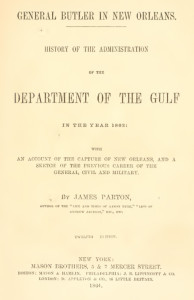
The French Consul in Mobile, in an effort to ease Heidsieck’s passage back to France, provided Heidsieck with a diplomatic pouch, which he was to deliver to the French Consulate in New Orleans. Once there, his plan was to charter a boat to either Cuba or Mexico, and then sail home to France.
The diplomatic pouch sealed Champagne Charlie’s fate. Among the documents were notes concerning the production of Confederate Army uniforms by French textile firms. When Heidsieck arrived in New Orleans, pouch in hand, Union General Benjamin F. ‘Beast’ Butler captured him. The diplomatic pouch was seized, its contents revealed, and Heidsieck was jailed in Fort Jackson, charged as a Confederate spy.
Heidsieck argued ignorance over the contents of the pouch. General Butler, in his notes sent to Washington, had a different opinion:
“I arrested him as a spy – I confined him as a spy – I should have tried him as a spy, and hanged him upon conviction as a spy, if I had not been interfered with by the government at Washington. He had when arrested a canvas wrapper of the size of a peck measure firmly bound up with cords covering letters from the French, Swiss, Prussian, and Belgian consuls, also a great number of letters to persons mostly rebels, or worse, intermeddling foreigners containing contraband intelligence.”
However he had earned the nickname Champagne Charlie, there’s no dispute that the man was famous, in the US and in France. The fight for his release began immediately. The French Consul in New Orleans demanded his release. The General was forced to hold his noose and explain the situation to the Secretary of State up in Washington, D.C. It took months, and grew to be known as The Heidsieck Incident. The French government pressed. Heidsieck, always putting on a good act, claimed he was growing sick, denied of his daily dose of Champagne – a charge General Butler found infuriating. Napoleon III, then the Emperor of France, is reported to have personally written to President Lincoln on Heidsieck’s behalf. Against General Butler’s fierce complaints, Heidsieck was released, and sent back to France.
Any normal story should have ended here, probably long before here. Champagne Charlie was broke, in poor health, and even if he had the means to produce any Champagne, his primary market was at war. He returned to France in November of 1862, ‘demoralized and broke.’
Denver
Only a few months later, an American missionary headed for France with instructions to locate Heidsieck. The brother of Heidsieck’s New York sales agent had given him a package to deliver to Heidsieck. Apparently the man was ‘ashamed’ of his brother’s actions, and so he offered repayment in the form of deeds to land in the Colorado Territory. Heidsieck wasn’t impressed. A few years later, those deeds would be the fuel to rebuild his business.
The deeds amounted to a third of what was then a small, obscure village in the Colorado Territory. The name of the village was Denver. Before the decade was over, the Civil War had ended, a new silver mining boom took hold of Colorado, and Denver’s population and wealth boomed as it was linked up to the Transcontinental Railroad and appointed the territorial capital. The stack of worthless deeds had grown wildly valuable. Heidsieck sold the land off and used the money to rebuild his Champagne business.
When Champagne Charlie passed away in 1893, his business was once again among the world’s leading producers of Champagne. The business survived him, passing through the hands of various owners. Only a year and a half ago, now in the hands of EPI, a firm owned by one of France’s wealthiest families, the Charles Heidsieck brand was ‘relaunched,’ with – what else – a new marketing campaign with the goal of repopularizing the brand throughout the world.
